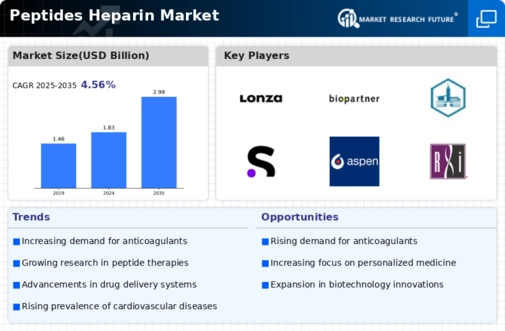Global Aging Population
The demographic shift towards an aging population significantly impacts the Global Peptides Heparin Market Industry. As individuals age, the risk of developing cardiovascular diseases and related complications increases, leading to a higher demand for effective anticoagulant therapies. This trend is particularly pronounced in developed regions, where healthcare systems are adapting to accommodate the needs of older adults. The Global Peptides Heparin Market Industry is likely to benefit from this demographic change, as healthcare providers increasingly prescribe heparin-based therapies to manage age-related health issues. This growing market segment underscores the importance of heparin in contemporary healthcare strategies.
Market Growth Projections
The Global Peptides Heparin Market Industry is projected to experience substantial growth over the next decade. With a market value anticipated to reach 2.99 USD Billion by 2035, the industry is poised for expansion driven by various factors, including technological advancements, increasing demand for anticoagulants, and supportive regulatory frameworks. The compound annual growth rate of 4.57% from 2025 to 2035 indicates a robust market trajectory, reflecting the ongoing evolution of heparin therapies and their integration into standard medical practices. This growth presents opportunities for stakeholders across the healthcare spectrum, from manufacturers to healthcare providers.
Rising Demand for Anticoagulants
The Global Peptides Heparin Market Industry experiences a notable increase in demand for anticoagulants, driven by the rising prevalence of cardiovascular diseases and thromboembolic disorders. As healthcare systems worldwide prioritize the management of these conditions, the market for heparin-based therapies is projected to reach 1.83 USD Billion in 2024. This growth is further supported by advancements in peptide synthesis technologies, which enhance the efficacy and safety profiles of heparin products. Consequently, the Global Peptides Heparin Market Industry is likely to witness sustained growth as healthcare providers increasingly adopt these therapies to improve patient outcomes.
Regulatory Support for Heparin Products
Regulatory bodies play a crucial role in shaping the Global Peptides Heparin Market Industry by establishing guidelines that facilitate the approval and commercialization of heparin products. Recent initiatives aimed at expediting the review process for new anticoagulant therapies have encouraged pharmaceutical companies to invest in heparin research and development. This regulatory support not only enhances market confidence but also fosters innovation in heparin formulations. As a result, the Global Peptides Heparin Market Industry is poised for growth, with an increasing number of heparin products entering the market, thereby expanding treatment options for healthcare providers and patients alike.
Increasing Awareness of Preventive Healthcare
The Global Peptides Heparin Market Industry benefits from the growing awareness of preventive healthcare measures among populations. As individuals become more informed about the risks associated with thromboembolic events, there is a corresponding increase in the demand for preventive therapies, including heparin. This trend is particularly evident in aging populations, where the incidence of cardiovascular diseases is higher. Consequently, healthcare providers are more likely to recommend heparin-based therapies as part of comprehensive care plans. This shift towards preventive healthcare is anticipated to contribute to a compound annual growth rate of 4.57% from 2025 to 2035 within the Global Peptides Heparin Market Industry.
Technological Advancements in Drug Development
Technological innovations in drug development significantly influence the Global Peptides Heparin Market Industry. The emergence of novel peptide synthesis techniques and purification methods enhances the quality and effectiveness of heparin products. These advancements not only streamline production processes but also reduce costs, making heparin therapies more accessible. As a result, the market is expected to grow, with projections indicating a value of 2.99 USD Billion by 2035. The integration of biotechnology in heparin production further supports this trend, as it allows for the development of more targeted therapies, thereby expanding the potential applications of heparin in various medical fields.


















Leave a Comment